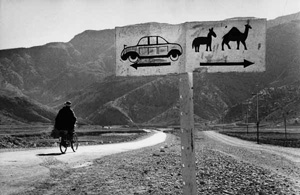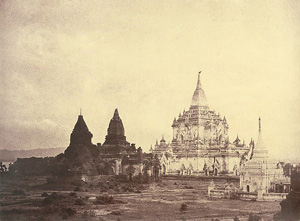Tourism Before Selfies
John Haberin New York City
Linnaeus Tripe and Marc Riboud
Photographers abroad have gone from mere vacationers to obstacles, standing in the way of exotic ruins and ancient temples. Long before selfies, though, in the nineteenth century, Linnaeus Tripe was traveling southern Asia in search of its heritage. One would hardly know that he was a British functionary in an age of empire and rebellion. One would hardly know, too, that he sought out a culture's life in the present.
Tripe raises an age-old question—the role of the artist as imperialist or tourist. Artists have always had patrons among the powerful, and adventurous artists have pursued their own vision as well, crossing continents. The pendulum in art history has swung toward seeing them as imposing a footprint on others, rather than freeing others to see. At the same time, museums are discovering how artists and photographers helped to reclaim and preserve the land they knew, like the American West. Was Tripe simply the tool of British commercial interests, indifferent to the lives of others in the present? Or was he opening up perspectives that actual empires would just as well suppress? 
The dilemmas hardly ended with the British tea trade, and one of the twentieth century's greatest photographers had to face them on very much the same soil. "You're still having trouble finding a story." Henri Cartier-Bresson was writing to Marc Riboud in Asia, where an entire continent, like photography for Cartier-Bresson, had come upon its "decisive moment." The older man could offer only sympathy and encouragement, but he need not have worried. Riboud had found countless stories, a sense of humanity, and a style. Now "Witness at a Crossroads" tells his story.
Finding a story
Start with his journeys. Born in 1923, just one year before Robert Frank in Switzerland, Marc Riboud began his three-year journey in 1955, on his way to Turkey, Iran, Afghanistan, Pakistan, India, Nepal, China, and Japan (a journey interrupted by his mother's illness). India had its first prime minister, and Mao had still to embark on the Great Leap Forward. A decade after World War II, country after country faced a choice between East and West, capitalism and communism, a rural economy and modernity. Then again, they could always choose neither or both. A photograph by the exhibition's entry shows the Khyber Pass, with arrows directing cars to the left and camels to the right, but a man in desert clothing hurtles onward by bicycle.
Riboud, too, was not one for taking sides, unlike Walker Evans in America or indeed his mentor in France. Where Henri Cartier-Bresson photographed a man sleeping under a bridge in The Decisive Moment, Riboud selects a man sleeping on a shelf beside the Hindu god of death and destruction. Where Cartier-Bresson has an artistry born of Surrealism, the artistry of a man leaping over his own shadow, Riboud's deepest shadows fall across a couple separated by the dark confines of their bedroom. Where Cartier-Bresson followed him to Asia in 1958 in pursuit of change, Riboud's subjects include a meeting of the Dalai Lama, Zhou Enlai, Indira Gandhi, and Jawaharlal Nehru. One has to wonder what was resolved.
Like Cartier-Bresson, he worked at once in art photography, commercial photography, street photography, photojournalism, as a member of Magnum Photos. Like the older man, too, he trusted his art to a hand-held Leica, a press pass, and a passport. The curator, Beth Citron, has a display case for all three. Thanks to Cartier-Bresson, he also carried introductions to Ravi Shankar and Satjayit Ray, and a contact sheet tracks Ray directing a film. Riboud photographed Mao and Zhou looking ambiguously thoughtful or calculating, but his real interest lay in ordinary people and a continent in motion. When he returned to China briefly in the 1960s, it showed no signs of slowing down.
Each country has for him its own stories, if not necessarily the expected ones. Turkey seems no closer to modernity, after years of Kemal Atatürk's wrenching secular reforms. Communities pack into makeshift wooden housing, and women hug one another between love and despair. In Pakistan (the birthplace as well of Shahzia Sikander and Salman Toor), children play and men show off together at the gym, but a young man hides behind a revolver, and another's dark eyes peer out threateningly and cautiously from behind the spokes of a wheel. Heads everywhere are bent, even as the camera engages them with sympathy. Women still wear burqas, and Riboud deemed their folds "wonderful."
Further east, the pageantry widens, and so does the ambiguity. People in India loll apart in the sunlight, creating their own elegant compositions, and a beheading in China belongs to a street show. Chinese look out from a cluster of broad windows, neither fully confined nor free. As a family struggles to convey a junk across the Yangtze, it could be continuing a task unchanged for centuries or caught up in a flood. Only Japan seems fully a part of what a 2010 retrospective of Cartier-Bresson called "The Modern Century." A worker on a skyscraper engages it in a turn close to a silent comedy or a dance, while crowds press into supermarkets and night clubs.
Riboud portrays them all as on a stage, much like the bedroom and the beheading. They may be creative actors intentionally, like art students in China, or unintentionally, like Chinese wielding umbrellas out of a garden party or René Magritte. An individual with a flower faces a row of soldiers with bayonets and rifles, and who knows who will survive the confrontation as they were? Ultimately, Riboud found his story in the contrast between inscrutable leaders and the human tapestry. He creates a psychology of mists and mountains, while faces remain at a distance even in close-up. In his warmth and objectivity, his equal trust as an artist in things and in people, he had also found his modernity.
A vision of India
I like to think of Linnaeus Tripe as quintessentially English. Even his name sounds like something out of a Monty Python routine. Had he not been an officer, I can imagine him at his desk each day, his bowler hat and umbrella by his side, putting his papers in order and filling out the same form again and again and again. But he did become a captain, stationed in what for Victorian England was "the jewel in the crown." Trained as a surveyor, he traveled first to India and then across the Bay of Bengal to Burma. Along the way, he became a pioneer of photography as a window onto Indian art.
He did not join the East India Tea Company in 1839 as a photographer. The medium was invented just that year. Yet he found himself in perhaps the greatest act of cultural imperialism ever. He taught himself the craft, starting back in England and trying it out on the quarterdeck of a ship to his new assignment. He set up his studio in Madras, on the southeast coast of India, and embraced the move from glass to waxed paper negatives, each 12 by 15 inches, for how else to carry the bulky equipment from temple to temple to photograph them all? And he left roughly twenty-five thousand salted paper prints.
 He started more modestly, in 1852, as a salaried employee in Burma. He never did profit from the sale of prints, although his family ended up with the negatives. The company, which then ran the British army there, was no doubt staking its claim to the region's heritage. No doubt, too, it could tell itself that it was not just exploiting land and labor, but doing everyone a favor as educator and preserver. Thanks to Tripe, though, the mission took on epic proportions, much like that of his namesake, Linnaeus, in biology. On his return to India after a short break, he resolved to photograph every temple in sight.
He started more modestly, in 1852, as a salaried employee in Burma. He never did profit from the sale of prints, although his family ended up with the negatives. The company, which then ran the British army there, was no doubt staking its claim to the region's heritage. No doubt, too, it could tell itself that it was not just exploiting land and labor, but doing everyone a favor as educator and preserver. Thanks to Tripe, though, the mission took on epic proportions, much like that of his namesake, Linnaeus, in biology. On his return to India after a short break, he resolved to photograph every temple in sight.
He did so methodically, accompanied by a topographic photographer to record the lay of the land. He stood back to see each site as a whole, then came closer to take in its carvings, ingeniously tilting his lenses to keep the camera level, and finally stepped inside. As an officer, he had the authority to close off a shrine to worshippers, so that he could go about the business of the long exposures needed without the blur of human traffic. One would never know that these temples were not crumbling, but in use. He was so determined to capture every detail that he assembled twenty-two prints into a panorama, on a huge scroll for others to unfurl. He need not have bothered, as ethnographers were taking rubbings, but he left nothing to chance.
I cannot really know him, much less his personality or his motives, but then neither can anyone else. He left no journal of his activities and hardly spoke of them in retirement. When the Brits shut down the project in 1860, he was only thirty-eight, and he simply returned to military service—but I think that one can still see what he had in mind. He was not out to awe the viewer with the artifacts or his art, unlike Maxime Ducamp at the monuments of Egypt and the Near East just a few years before him. He was documenting a time and place, like Carleton Watkins in Yosemite or Mathew Brady in the Civil War, but without the first's mission to establish a landmark and the latter's to make history. He was only out to leave no wood or stone unturned.
His photographs at the Met may look ethereal in reproduction, but they are stolid and clear. Tripe mostly framed his compositions tightly and symmetrically, in strong contrasts of light and dark, so that small temples loom large, while the Great Pagoda in what was then Tanjore seems relatively modest. He had no eye for politics, living conditions, or local culture, even in a decade of outright rebellion that caused the British government to assume control of the military. Every so often, one can see shifting clouds in the sky, reflections on water, or a colonnade of shadows, but his art was only incidentally an art. He touched up foliage less for effect than to eliminate distractions. Yet he helped create the present-day sense of photography as the equal or embodiment of vision.

Linnaeus Tripe ran at The Metropolitan Museum of Art through May 25, 2015, "Witness at a Crossroads: Marc Riboud in Asia" at the Rubin Museum of Art through March 23, 2014. Both reviews first appeared in a slightly different form in New York Photo Review.




